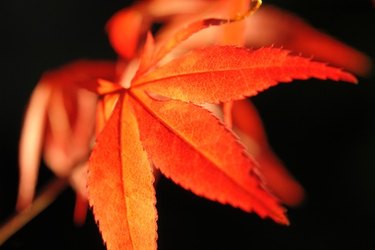
Deciduous trees, maples routinely lose their leaves in the fall. Chlorophyll, the critical agent processing sunlight, water and other nutrients through photosynthesis, dies as temperatures grow cold. Leaves fall, to be replaced by spring growth. Leaf fall at other times of year, however, can signal other problems for maple trees.
The Normal Cycle
Video of the Day
Broadleaf, or deciduous, trees customarily send out new leaves in the spring. Leaves fill with green chlorophyll, which uses sunlight, water and nutrients in a process called photosynthesis, to nourish the tree. As temperatures warm, leaves become greener and larger. At summer's end, cooling temperatures kill off chlorophyll, exposing underlying leaf tissue colors (what we call "fall foliage") and causing leaves to fall. Trees enter a low-growth dormancy until temperatures warm the following spring, letting the cycle repeat.
Video of the Day
Early Spring Leaf Loss
Pest infestation may be one cause of spring leaf loss. Maple petiole borer works its way into the petiole, the part of the leaf stem attached to the tree branch, loosening it and causing leaf drop. Extension agents recommend insecticide only for severe cases.
Spring-Summer Disease Issues
Maples can lose leaves as a symptom of disease. Common ailments include maple decline, anthracnose, and verticillium wilt. Planting trees with adequate air circulation around them and providing adequate nutrition can strengthen trees to fight off infection and disease.
Full-Season Nutritional Needs
Soil conditions can have large effects on the viability of young trees. Maples are often selected as handsome, relatively sturdy candidates for street-side planting or to replace old, removed trees. To do well, maples prefer slightly acid soil; disturbed soil may be too alkaline, or contain too much debris and sand to be helpful to plant growth. Soil drainage and improvement with amendments like mulch may been needed.
Water and Leaf Loss
As with any new tree or shrub, watering regularly and deeply makes an enormous difference in plant or tree survival. Dry spells, poor soil drainage and overall lack of water reflect anywhere from two weeks to six months in a plant's health. Regular watering should be part of the maintenance program for any new tree becoming established; a full season of planned watering can compensate for uneven weather.
Accident & Trauma
A tree that displays sudden or extensive leaf loss may be displaying delayed signs of stress. Check around the roots of the tree to determine if stress or trauma to roots or bark. A truck can crush roots or remove bark strips enough to damage branches and leaf drop can be the first sign of trouble.
Air Quality Issues
Urban trees struggle with many stresses. A particular urban stress is air pollution. Colorado State Extension notes, for example, that Denver trees display a variety of damages to leaves because of the city's "brown cloud." In the absence of other stresses, explore the impact of air quality on failing trees.